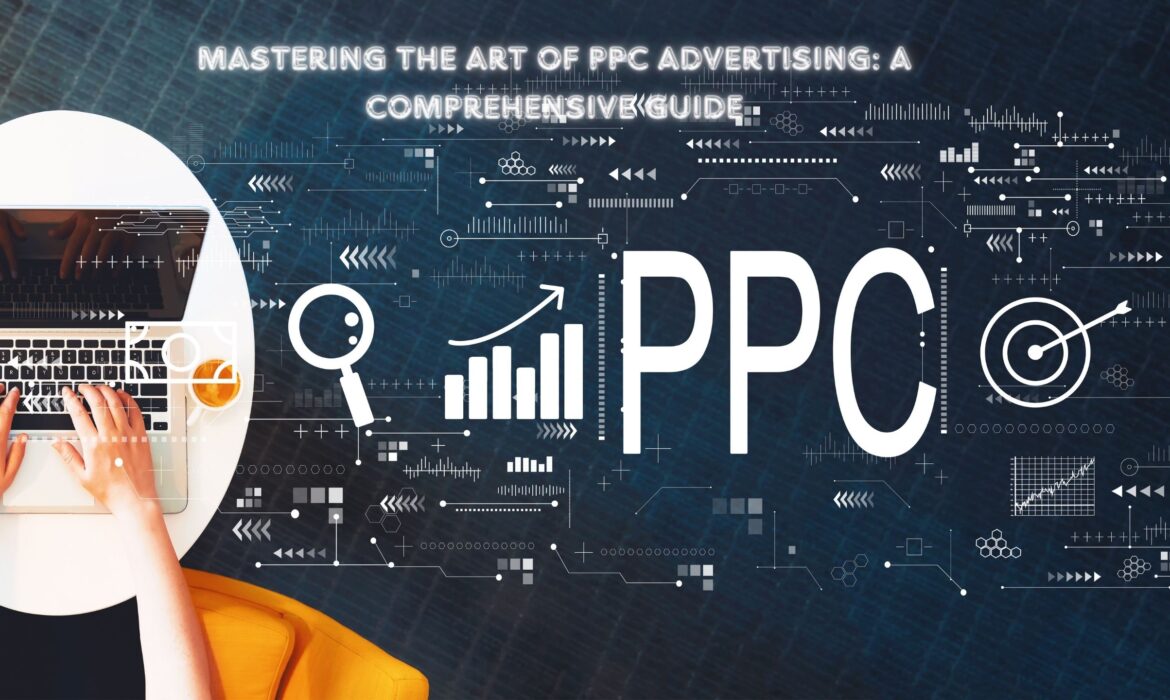
Introduction to PPC Advertising
In the world of online advertising, PPC advertising plays a crucial role in driving targeted traffic to websites and generating conversions. In this section, we will explore what PPC advertising is and the benefits it offers to businesses.
What is PPC Advertising?
PPC, which stands for Pay-Per-Click, is an online advertising model where advertisers pay a fee each time their ad is clicked on. It is a form of search engine marketing that allows advertisers to display their ads on search engine results pages (SERPs) and other relevant websites. The most popular PPC platform is Google Ads, but other platforms like Bing Ads also offer PPC advertising opportunities.
With PPC advertising, advertisers bid on specific keywords relevant to their business or target audience. When a user searches for these keywords, the ads are displayed at the top or bottom of the search results. Advertisers only pay when their ads are clicked on, hence the name “Pay-Per-Click”. This model provides a cost-effective way to reach potential customers and drive traffic to websites.
Benefits of PPC Advertising
PPC advertising offers several benefits that make it a valuable tool for businesses:
-
Immediate Results: PPC advertising can generate immediate results, with advertisers seeing an increase in website traffic and conversions shortly after launching their campaigns (Search Engine Journal). This makes it an excellent choice for businesses looking for quick visibility and results.
-
Precise Targeting: One of the key advantages of PPC advertising is the ability to target specific audiences. Advertisers can select specific keywords, demographics, geographic locations, and even device types to reach their desired audience (Search Engine Journal). This precise targeting ensures that ads are shown to the most relevant potential customers, increasing the chances of generating conversions.
-
Measurable Results: PPC advertising provides measurable results, allowing advertisers to track their campaign performance, set clear goals, and make data-driven decisions to optimize their campaigns (Search Engine Journal). The availability of detailed metrics and analytics helps advertisers understand the effectiveness of their ads, keywords, and targeting, enabling them to make adjustments to improve performance.
-
Cost-Effectiveness: PPC advertising is cost-effective since advertisers only pay when their ads are clicked on. This pay-per-click model allows businesses to control their advertising budget and avoid wasted spending. Advertisers can set daily or monthly budgets, ensuring that they only spend what they can afford while still reaching their target audience.
-
Brand Visibility and Awareness: By appearing at the top of search engine results pages, PPC ads increase brand visibility and awareness. This prime placement enhances brand exposure and attracts potential customers, even if they don’t click on the ads immediately (Search Engine Journal). The repeated exposure to the brand can create a lasting impression and influence future purchasing decisions.
PPC advertising offers businesses a powerful way to reach their target audience, generate website traffic, and drive conversions. Its immediate results, precise targeting, measurable performance, cost-effectiveness, and brand visibility make it a valuable component of a comprehensive digital marketing strategy.
Getting Started with PPC Advertising
When venturing into the world of PPC advertising, it’s important to understand the basics and take the right steps to set yourself up for success. This section will guide you through the initial stages of getting started with PPC advertising, including choosing the right PPC platform and setting up your first PPC campaign.
Choosing the Right PPC Platform
One of the first decisions you’ll need to make is selecting the PPC platform that best suits your needs. The most popular and widely used platform is Google Ads, previously known as Google AdWords. Google Ads allows advertisers to bid on keywords relevant to their products or services and display their ads on Google’s search engine results pages (SERPs) (Search Engine Land). With its extensive reach and advanced targeting options, Google Ads offers a powerful platform for reaching your target audience.
Another PPC platform to consider is Bing Ads, which enables advertisers to display their ads on the Bing search engine. While Bing’s search volume may be lower compared to Google, it can still provide valuable exposure, particularly for specific target audiences. It’s worth exploring Bing Ads as a complementary platform to Google Ads to maximize your reach.
When choosing a PPC platform, consider factors such as audience reach, keyword targeting capabilities, ad formats, and budget requirements. Each platform has its own strengths and targeting options, so it’s important to evaluate them based on your specific goals and target audience.
Setting Up a PPC Campaign
Once you’ve chosen the right PPC platform, it’s time to set up your first PPC campaign. This process involves several key steps to ensure your campaign is properly structured and optimized for success.
-
Define Your Goals: Start by clearly defining your campaign objectives. Are you aiming to generate leads, increase website traffic, or drive conversions? Identifying your goals will help you tailor your campaign strategy and measure its success.
-
Keyword Research: Conduct thorough keyword research to identify the most relevant and effective keywords for your campaign. Consider using keyword research tools to discover high-volume, low-competition keywords that align with your business objectives.
-
Ad Creation: Craft compelling ad copy and design engaging visuals that resonate with your target audience. Ad copy should be concise, persuasive, and highlight the unique value proposition of your product or service. Be sure to adhere to the platform’s ad guidelines and best practices.
-
Budget Allocation: Determine your budget for the campaign. Start with a budget that aligns with your goals and gradually optimize it based on performance. Consider factors such as the competitiveness of keywords and your desired ad placement.
-
Targeting Options: Utilize the targeting options provided by the PPC platform to narrow down your audience based on factors such as location, demographics, and search intent. Targeting specific audiences ensures your ads are shown to the right people at the right time.
-
Ad Scheduling: Consider scheduling your ads to run during specific days or times when your target audience is most likely to be active. This can help optimize your ad spend and maximize the impact of your campaign.
-
Tracking and Analytics: Implement conversion tracking and analytics tools to measure the performance of your PPC campaign. Monitor key metrics such as impressions, clicks, conversions, and return on ad spend (ROAS) to gain insights into the effectiveness of your campaign.
Remember, setting up a PPC campaign is just the beginning. Ongoing monitoring, optimization, and testing are essential to ensure the success of your campaign. Stay tuned for the next section on key elements of a successful PPC campaign, where we’ll dive deeper into strategies for optimizing your ads and maximizing your ROI.
Key Elements of a Successful PPC Campaign
To create a successful PPC (Pay-Per-Click) campaign, it’s crucial to focus on three key elements: keyword research and selection, ad copy and design, and landing page optimization.
Keyword Research and Selection
Effective keyword research and selection are fundamental to a successful PPC campaign. It involves identifying the search terms that are relevant to your target audience and have high search volume. By understanding the keywords your audience is using, you can tailor your ads to appear when they search for those specific terms.
Keyword research tools, such as Google Ads and Bing Ads, can help you identify relevant keywords and provide insights into search volume and competition. It’s important to choose keywords that align with your campaign goals and target audience. Consider the search intent behind each keyword and select those that are most likely to result in conversions.
Ad Copy and Design
Once you have selected your target keywords, crafting compelling ad copy and design is essential to attract clicks and drive conversions. Ad relevancy is a critical factor in PPC advertising, as search engines prioritize ads that are relevant to the user’s search query. Tailor your ad copy to align with the keywords you have chosen and ensure it addresses the user’s needs or offers a solution to their problem.
Your ad copy should be concise, clear, and compelling. Highlight the unique selling points of your product or service and include a strong call-to-action (CTA) to encourage users to click on your ad. Consider using ad extensions, such as sitelink extensions or call extensions, to provide additional information and improve the visibility of your ads.
Design also plays a crucial role in the effectiveness of your ads. Use eye-catching visuals and ensure that your ad design is consistent with your brand identity. Make sure your ads are optimized for different devices, as an increasing number of users access the internet through mobile devices.
Landing Page Optimization
Even the most engaging ads won’t be effective without a well-optimized landing page. Once users click on your ad, they should be directed to a landing page that is relevant to their search query and provides a seamless user experience. The landing page should align with the ad copy and design, reinforcing the message and offering a clear path to conversion.
Optimize your landing page by ensuring fast loading times, clear and concise content, and a prominent call-to-action. Make the conversion process simple and intuitive, minimizing any friction that may deter users from completing the desired action. Continuously test and optimize your landing page to improve its performance and maximize conversions.
By focusing on these key elements, you can create a PPC campaign that effectively targets your audience, captures their attention with compelling ad copy and design, and guides them to a well-optimized landing page. Remember to regularly monitor and optimize your campaign to ensure it continues to deliver the desired results.
Monitoring and Optimizing PPC Campaigns
To ensure the success of your PPC advertising efforts, it is essential to continuously monitor and optimize your campaigns. This involves tracking performance metrics, conducting A/B testing and experimentation, as well as implementing effective budget management and bid strategies. Let’s explore each of these aspects in more detail.
Tracking Performance Metrics
Tracking performance metrics is crucial in evaluating the effectiveness of your PPC campaigns. By monitoring key metrics such as click-through rate (CTR), conversion rate, cost per click (CPC), and return on ad spend (ROAS), you can gain valuable insights into the performance of your ads and make data-driven decisions to optimize your campaigns. Utilize tools like Google Ads and Bing Ads to access comprehensive performance data and analytics.
| Performance Metric | Definition |
|---|---|
| Click-Through Rate (CTR) | Percentage of people who click on your ad after seeing it. |
| Conversion Rate | Percentage of ad clicks that result in a desired action, such as a purchase or form submission. |
| Cost Per Click (CPC) | Average cost incurred for each click on your ad. |
| Return on Ad Spend (ROAS) | Measure of the revenue generated for every dollar spent on advertising. |
Source: Search Engine Journal, Ruler Analytics
A/B Testing and Experimentation
A/B testing and experimentation play a vital role in optimizing your PPC campaigns. By creating multiple versions of your ads and landing pages, you can test different elements, such as headlines, ad copy, call-to-action buttons, and visuals, to determine which variations perform the best. This iterative testing process allows you to refine your campaigns and maximize their effectiveness. Remember to test one element at a time to accurately identify the impact of each change.
Implementing A/B testing and experimentation can help you improve click-through rates, conversion rates, and overall campaign performance. It’s important to carefully analyze the results and make data-driven decisions based on the findings. By continually testing and refining your PPC campaigns, you can drive better results and increase your return on investment (ROI).
Budget Management and Bid Strategies
Effectively managing your budget is essential for optimizing the performance of your PPC campaigns. Allocate your budget strategically to high-performing keywords and ads that generate the best results. Regularly review your campaign data to identify areas where you can adjust your budget allocation to maximize return on investment.
Implementing bid strategies is another critical aspect of optimizing your PPC campaigns. Bid strategies determine how much you are willing to pay for each click or conversion. Depending on your goals, you can choose bid strategies that focus on maximizing clicks, conversions, or target return on ad spend (ROAS). Experiment with different bid strategies to find the one that aligns with your objectives and delivers the best results.
By monitoring performance metrics, conducting A/B testing and experimentation, and implementing effective budget management and bid strategies, you can continuously optimize your PPC campaigns for better results. Remember, data analysis is key to understanding the impact of your campaigns and making informed decisions. Stay up-to-date with industry trends and best practices to ensure your PPC advertising efforts remain effective and competitive.
Maximizing ROI in PPC Advertising
When it comes to PPC advertising, maximizing the return on investment (ROI) is a crucial goal for advertisers. By effectively calculating and improving ROI, businesses can ensure that their PPC campaigns are not only driving traffic and conversions but also delivering a positive impact on revenue. In this section, we will explore key strategies to maximize ROI in PPC advertising.
Calculating Return on Ad Spend (ROAS)
Calculating the return on ad spend (ROAS) is an essential step in measuring the effectiveness of your PPC campaigns and determining the success of your advertising efforts. ROAS is the ratio of revenue generated from the campaign compared to the cost of the ads. To calculate ROAS, you can use the following formula:
ROAS = (Revenue – Cost of Ads) / Cost of Ads * 100
For example, if you spent $500 on ads and generated $2,000 in revenue, the ROAS would be:
ROAS = ($2,000 – $500) / $500 * 100 = 300%
Tracking and analyzing your ROAS allows you to identify which campaigns are driving the most revenue and adjust your budget allocation accordingly. By understanding the ROI of your PPC campaigns, you can make data-driven decisions and optimize your advertising strategies for maximum impact. For a more detailed guide on PPC ROI, visit our article on PPC ROI.
Strategies for Increasing ROI
To increase ROI in PPC advertising, it’s essential to implement effective strategies that optimize your campaigns and drive better results. Here are some strategies to consider:
-
Keyword Optimization: Continuously analyze and refine your keyword selection to ensure your ads are targeting the most relevant audience. Use tools like Google Ads and Bing Ads to identify high-performing keywords and eliminate underperforming ones.
-
Ad Copy and Design: Craft compelling ad copy and design that aligns with your target audience’s needs and interests. A clear and persuasive message, coupled with attention-grabbing visuals, can improve click-through rates and conversions.
-
Landing Page Optimization: Optimize your landing pages to provide a seamless and relevant user experience. Ensure that the landing page content aligns with the ad copy and keywords, and include strong call-to-action (CTA) elements to drive conversions.
-
Ad Scheduling: Analyze your campaign data to identify the most effective times and days for running your ads. By scheduling your ads during peak periods when your target audience is most active, you can maximize your chances of reaching potential customers.
-
Geotargeting: Refine your PPC campaigns by targeting specific geographical locations where your target audience is located. This allows you to focus your budget on areas that are most likely to generate conversions and minimize ad spend wastage.
Importance of Data Analysis
Data analysis plays a crucial role in maximizing ROI in PPC advertising. By regularly analyzing key performance metrics, such as impressions, clicks, conversions, and ROI, you can gain valuable insights into the effectiveness of your campaigns. This data-driven approach enables you to identify trends, optimize underperforming campaigns, and make informed decisions to improve ROI.
Utilize tools like SEMrush and Google Analytics to track and measure the performance of your PPC campaigns. Analyze the data to identify areas for improvement, test different strategies through A/B testing, and iterate on your campaigns to maximize ROI.
By calculating ROAS, implementing effective strategies, and leveraging data analysis, you can optimize your PPC campaigns and maximize your return on investment. Remember that continuous monitoring, testing, and refinement are key to driving success in PPC advertising. Stay up-to-date with industry trends and best practices to ensure that your campaigns remain competitive and effective in achieving your business goals.
Advanced PPC Advertising Techniques
To truly master the art of PPC advertising, it’s important to explore advanced techniques that can take your campaigns to the next level. In this section, we will delve into three advanced techniques: remarketing and retargeting, dynamic search ads, and ad extensions and ad formats.
Remarketing and Retargeting
Remarketing and retargeting are powerful techniques that allow advertisers to target users who have previously interacted with their website or shown interest in their products or services. By using tracking pixels or cookies, advertisers can re-engage potential customers and increase conversion rates.
The main difference between remarketing and retargeting lies in the platforms used. Remarketing typically refers to targeting users through display ads on the Google Display Network, while retargeting involves targeting users through other platforms, such as social media or third-party websites.
Remarketing and retargeting campaigns can be highly effective because they allow advertisers to reach an audience that has already shown interest in their brand. By presenting tailored ads to these users, advertisers can reinforce their messaging and encourage them to take action. According to Digivate, remarketing campaigns can increase conversion rates by up to 70% compared to non-remarketing campaigns.
Dynamic Search Ads
Dynamic search ads are a type of PPC advertising that automatically generates ads based on the content of a website or specific landing pages. This eliminates the need for manual keyword research and ad creation, making it a time-saving and efficient option for advertisers.
With dynamic search ads, the search engine’s algorithm determines when to display your ads based on the relevance of the search query to the content on your website. This allows advertisers to reach a wider audience and target relevant keywords that may not have been covered through traditional keyword targeting methods.
By leveraging dynamic search ads, advertisers can capture additional traffic and increase conversions. According to Search Engine Land, dynamic search ads can help target relevant search queries that may not have been covered by traditional keyword targeting methods, ultimately leading to higher conversion rates.
Ad Extensions and Ad Formats
Ad extensions and ad formats play a crucial role in enhancing the visibility and effectiveness of PPC ads. Ad extensions allow advertisers to include additional pieces of information that provide more context and encourage user interaction. Examples of ad extensions include call buttons, site links, location information, and more.
By utilizing ad extensions, advertisers can improve click-through rates (CTR) and provide valuable information to users, increasing the chances of them taking action. According to Search Engine Land, ad extensions can improve CTR by up to 30%, making them an important tool for optimizing PPC campaigns.
Ad formats, on the other hand, refer to the different types of ads available in PPC advertising. These can include text ads, display ads, video ads, and shopping ads, among others. Each ad format has its own unique characteristics and advantages, enabling advertisers to choose the format that best aligns with their campaign goals.
By leveraging ad formats such as video ads, advertisers can create highly engaging and visually appealing content that has a higher chance of capturing users’ attention and driving conversions. Ad extensions and ad formats together allow advertisers to provide additional information, enhance the visual appeal of their ads, and ultimately increase the chances of attracting clicks and conversions.
As you explore these advanced PPC advertising techniques, keep in mind that continuous experimentation and optimization are key. By testing different strategies and analyzing data, you can fine-tune your campaigns to maximize their effectiveness and drive optimal results.
Challenges and Best Practices in PPC Advertising
Navigating the world of PPC advertising comes with its own set of challenges. However, by implementing best practices, advertisers can overcome these obstacles and maximize the effectiveness of their campaigns. Here are some key challenges and best practices to consider:
Managing Competition and Ad Costs
One of the primary challenges in PPC advertising is managing competition and ad costs. As more businesses recognize the value of PPC advertising, competition for ad placements increases. This can drive up the cost per click (CPC) and make it harder to achieve a positive return on investment (ROI).
To effectively manage competition and ad costs, consider the following best practices:
- Keyword Research and Selection: Conduct thorough keyword research to identify relevant and targeted keywords that have lower competition. Long-tail keywords can be particularly effective in reaching a more specific audience while potentially reducing competition.
- Ad Quality and Relevancy: Create compelling and relevant ad copy that resonates with your target audience. High-quality ads with relevant messaging are more likely to receive higher click-through rates (CTRs) and can potentially lower the cost per click.
- Budget Allocation and Bid Strategies: Carefully allocate your advertising budget across campaigns and ad groups based on their performance. Utilize bid strategies, such as automated bidding, to optimize your bids and maximize the value of each click.
Ad Quality and Relevancy
Maintaining ad quality and relevancy is crucial for the success of your PPC campaigns. Search engines prioritize ads that provide a positive user experience and are relevant to the user’s search intent. Failing to meet these standards can result in lower ad positions, reduced visibility, and lower CTRs.
To improve your ad quality and relevancy, consider the following best practices:
- Keyword-Ad Copy Alignment: Ensure that your ad copy aligns with the keywords you are targeting. Craft compelling headlines and descriptions that accurately reflect the content on your landing page.
- Landing Page Optimization: Create optimized landing pages that are directly relevant to your ads. Make sure that the landing page offers valuable information and a clear call to action. A seamless user experience from ad click to landing page can improve ad quality and increase conversion rates.
- Ad Extensions and Ad Formats: Take advantage of ad extensions, such as sitelinks, call extensions, and structured snippets, to provide additional information and increase the visibility of your ads. Experiment with different ad formats, such as responsive search ads, to test what resonates best with your audience.
Staying Up-to-Date with Industry Trends
The field of PPC advertising is constantly evolving, with new trends, technologies, and strategies emerging regularly. Staying up-to-date with these changes is essential to remain competitive and make informed decisions.
To stay ahead of the curve, consider the following best practices:
- Continuous Learning and Education: Stay informed by reading industry publications, attending webinars, and participating in relevant forums and communities. This will help you stay updated on the latest trends and best practices in PPC advertising.
- Testing and Experimentation: Embrace a culture of testing and experimentation to discover new strategies and tactics that work best for your specific business and target audience. Test different ad variations, landing page designs, and targeting options to identify what drives the best results.
- Utilize Data Analysis: Regularly analyze the performance data of your PPC campaigns to identify trends, patterns, and areas for improvement. Leverage analytics tools and conversion tracking to gain insights into the effectiveness of your campaigns and make data-driven optimizations.
By managing competition and ad costs, ensuring ad quality and relevancy, and staying up-to-date with industry trends, advertisers can navigate the challenges of PPC advertising and drive successful campaigns. Remember to monitor and regularly optimize your campaigns based on data-driven insights to continuously improve your results.










